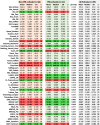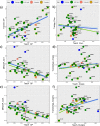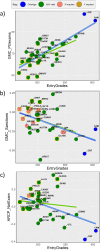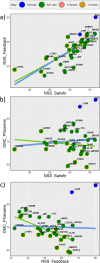Exploring UK medical school differences: the MedDifs study of selection, teaching, student and F1 perceptions, postgraduate outcomes and fitness to practise
- PMID: 32404148
- PMCID: PMC7222458
- DOI: 10.1186/s12916-020-01572-3
Exploring UK medical school differences: the MedDifs study of selection, teaching, student and F1 perceptions, postgraduate outcomes and fitness to practise
Abstract
Background: Medical schools differ, particularly in their teaching, but it is unclear whether such differences matter, although influential claims are often made. The Medical School Differences (MedDifs) study brings together a wide range of measures of UK medical schools, including postgraduate performance, fitness to practise issues, specialty choice, preparedness, satisfaction, teaching styles, entry criteria and institutional factors.
Method: Aggregated data were collected for 50 measures across 29 UK medical schools. Data include institutional history (e.g. rate of production of hospital and GP specialists in the past), curricular influences (e.g. PBL schools, spend per student, staff-student ratio), selection measures (e.g. entry grades), teaching and assessment (e.g. traditional vs PBL, specialty teaching, self-regulated learning), student satisfaction, Foundation selection scores, Foundation satisfaction, postgraduate examination performance and fitness to practise (postgraduate progression, GMC sanctions). Six specialties (General Practice, Psychiatry, Anaesthetics, Obstetrics and Gynaecology, Internal Medicine, Surgery) were examined in more detail.
Results: Medical school differences are stable across time (median alpha = 0.835). The 50 measures were highly correlated, 395 (32.2%) of 1225 correlations being significant with p < 0.05, and 201 (16.4%) reached a Tukey-adjusted criterion of p < 0.0025. Problem-based learning (PBL) schools differ on many measures, including lower performance on postgraduate assessments. While these are in part explained by lower entry grades, a surprising finding is that schools such as PBL schools which reported greater student satisfaction with feedback also showed lower performance at postgraduate examinations. More medical school teaching of psychiatry, surgery and anaesthetics did not result in more specialist trainees. Schools that taught more general practice did have more graduates entering GP training, but those graduates performed less well in MRCGP examinations, the negative correlation resulting from numbers of GP trainees and exam outcomes being affected both by non-traditional teaching and by greater historical production of GPs. Postgraduate exam outcomes were also higher in schools with more self-regulated learning, but lower in larger medical schools. A path model for 29 measures found a complex causal nexus, most measures causing or being caused by other measures. Postgraduate exam performance was influenced by earlier attainment, at entry to Foundation and entry to medical school (the so-called academic backbone), and by self-regulated learning. Foundation measures of satisfaction, including preparedness, had no subsequent influence on outcomes. Fitness to practise issues were more frequent in schools producing more male graduates and more GPs.
Conclusions: Medical schools differ in large numbers of ways that are causally interconnected. Differences between schools in postgraduate examination performance, training problems and GMC sanctions have important implications for the quality of patient care and patient safety.
Keywords: Fitness to practise; GMC sanctions; Institutional histories; Medical school differences; National Student Survey; National Training Study; Postgraduate qualifications; Preparedness; Problem-based learning; Teaching styles.
Conflict of interest statement
ICM is a member of the UKMED Advisory Board and the UKMED Research Subgroup. DTS is employed in the GMC as a data analyst working on the UKMED project and is a member of the UKMED Advisory Board and the UKMED Research Subgroup. The views expressed here are DTS’s own views and not the views of the GMC or any other body. Other authors declare that they have no competing interests, and all views expressed are those of the authors and not organisations of which they are members.
Figures








Similar articles
-
The Analysis of Teaching of Medical Schools (AToMS) survey: an analysis of 47,258 timetabled teaching events in 25 UK medical schools relating to timing, duration, teaching formats, teaching content, and problem-based learning.BMC Med. 2020 May 14;18(1):126. doi: 10.1186/s12916-020-01571-4. BMC Med. 2020. PMID: 32404194 Free PMC article.
-
Assessment at UK medical schools varies substantially in volume, type and intensity and correlates with postgraduate attainment.BMC Med Educ. 2015 Sep 11;15:146. doi: 10.1186/s12909-015-0428-9. BMC Med Educ. 2015. PMID: 26362320 Free PMC article.
-
Fitness to practise sanctions in UK doctors are predicted by poor performance at MRCGP and MRCP(UK) assessments: data linkage study.BMC Med. 2018 Dec 7;16(1):230. doi: 10.1186/s12916-018-1214-4. BMC Med. 2018. PMID: 30522486 Free PMC article.
-
Do we need a core curriculum for medical students? A scoping review.BMJ Open. 2019 Aug 30;9(8):e027369. doi: 10.1136/bmjopen-2018-027369. BMJ Open. 2019. PMID: 31473611 Free PMC article.
-
Impact of summer programmes on the outcomes of disadvantaged or 'at risk' young people: A systematic review.Campbell Syst Rev. 2024 Jun 13;20(2):e1406. doi: 10.1002/cl2.1406. eCollection 2024 Jun. Campbell Syst Rev. 2024. PMID: 38873396 Free PMC article. Review.
Cited by
-
Radiology teaching improves Anatomy scores for medical students.Br J Radiol. 2020 Oct 1;93(1114):20200463. doi: 10.1259/bjr.20200463. Epub 2020 Aug 14. Br J Radiol. 2020. PMID: 32795181 Free PMC article.
-
Social and psychological impact of the COVID-19 pandemic on UK medical and nursing students: protocol for a national medical and nursing student survey.BMJ Open. 2022 May 6;12(5):e057467. doi: 10.1136/bmjopen-2021-057467. BMJ Open. 2022. PMID: 35523504 Free PMC article.
-
Transitional challenges faced by medical intern doctors (IDs) in Vanuatu: a qualitative study.Med Educ Online. 2022 Dec;27(1):2005458. doi: 10.1080/10872981.2021.2005458. Med Educ Online. 2022. PMID: 34821207 Free PMC article.
-
Big data analysis: examination of the relationship between candidates' sociodemographic characteristics and performance in the UK's Membership of the Royal College of Physicians Part 1 examination.Adv Health Sci Educ Theory Pract. 2025 Feb;30(1):53-68. doi: 10.1007/s10459-024-10406-3. Epub 2024 Dec 20. Adv Health Sci Educ Theory Pract. 2025. PMID: 39704960 Free PMC article.
-
Putting nutrition education on the table: development of a curriculum to meet future doctors' needs.Br J Nutr. 2022 Sep 12;129(6):1-9. doi: 10.1017/S0007114522001635. Online ahead of print. Br J Nutr. 2022. PMID: 36089804 Free PMC article.
References
-
- General Medical Council: Be prepared: are new doctors safe to practise? Manchester: General Medical Council (Available at https://www.gmc-uk.org/Be_prepared___are_new_doctors_safe_to_practise_Oc...); 2014.
-
- General Medical Council . Basic medical education in the British Isles : the report of the GMC survey of basic medical education in the United Kingdom and Republic of Ireland, 1975-6. London: Nuffield Provincial Hospitals Trust; 1977.
-
- Medical Acts Commission . Report of the Royal Commissioners appointed to inquire into the Medical Acts. 1882.
-
- Bligh J, Eva K, Galbraith R, Ringsted C, van der Vleuten C, Brice J: Appendix 4: selection and assessment procedures used in selection for specialist training: report of an expert advisory panel for the Tooke enquiry (July 2007). In Aspiring to excellence: findings and recommendations of the independent inquiry into modernising medical careers, led by Professor Sir John Tooke, Available for download at https://www.medschools.ac.uk/media/2578/aspiring-to-excellence-report.pdf). London: Medical Schools Council; 2008:171–189.
MeSH terms
LinkOut - more resources
Full Text Sources
Miscellaneous

